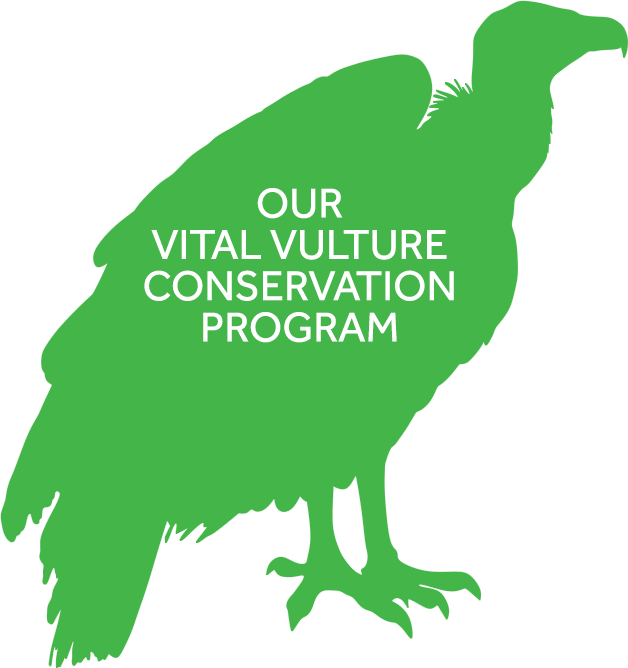
The Story of India's Vultures
The Indian subcontinent was once home to tens of millions of vultures. From 1985 however, the population of vultures dramatically declined, such that by 2007 the populations of oriental white-backed vultures had declined by a staggering 99.9%. This species was once considered to be the most populous species of raptor in the whole world and was in a short period of time declared international Critically Endangered and on the verge of extinction. The long-billed and sender-billed vultures were also observed to have declined at similar rates across the whole of South Asia and thrust into a similar state of peril.
Research biologists from the Bombay Natural History Society (BNHS), Bird Conservation Nepal (BCN) and the Ornithological Society of Pakistan (OSP) joined hands with international partners, the Royal Society for the Protection of Birds (RSPB, UK), Zoological Society of London (UK) and the Peregrine Fund (USA) to solve the mystery of these vulture declines. They were soon joined by other organizations to form a consortium to Save Asia’s Vultures from Extinction (SAVE).
In 2020, Savera Charitable Trust joins the movement.
Through the collection of dead and dying vulture carcasses, researchers quickly established that 84% of dead birds in India, Nepal and Pakistan were characterized by the presence of extensive visceral gout. Visceral gout is caused by a buildup of uric acid, which at very high levels crystallizes in the body thus coating all internal organs in a white ‘paste’. The presence of visceral gout in vultures suggested that the cause of death was likely to be related to kidney failure. In fact, some birds appeared sick and lethargic for a protracted period before death, with a characteristic ‘drooping head’.
Dead birds were tested for pesticides, herbicides, toxic heavy metals and other environmental pollutants. Nonetheless researchers were baffled to find that while trace levels of some of these compounds were detected, in the majority they were at insufficient levels to cause physiological damage. Furthermore, there was no link between these compounds and the gout found in most dead birds.
Then, in 2003, came the diclofenac breakthrough. Scientific researchers recognized a link between a class of painkillers known as Non-Steroidal Anti-Inflammatory Drugs (NSAIDs) to kidney failure and cases of visceral gout in birds. The team found that the new NSAID, diclofenac, had recently come on sale and was commonly available. Investigations of carcasses showed that every bird that had visceral gout also had traces of diclofenac and those with no gout had no diclofenac.
In 2004 the results of this work were published in the journal Nature and extensive research was conducted which established the same correlation between gout and diclofenac in India and Nepal. The results showed that the dead vultures had been feeding on the carcasses of cattle that had been treated with diclofenac. Something that no one could have anticipated.
Subsequently, scientific modeling has shown that if just under 1% of cow carcasses contained diclofenac it would be enough to cause the vulture population to decline at the precipitous rate observed.
The conclusive findings on diclofenac, as the main cause of vulture declines in South Asia, led to its official ban in India. However, diclofenac is not the only vulture-toxic Non-Steroidal Anti-inflammatory Drug (NSAID) in use. Other veterinary NSAIDS are now competing in the market, namely: aceclofenac, carprofen, flunixin, ketoprofen, nimesulide, and phenylbutazone, some of which are also known or suspected to be toxic to vultures.
Currently, the only scientifically confirmed vulture-safe NSAID is meloxicam, but there are others that show promise.

1996
Recognised massive decline in Asia’s vultures.
2004
RSPB and BNHS launch a conversation breeding program and initiate efforts to request a diclofenac ban.
2006
India, Pakistan, and Nepal governments ban the use of diclofenac.
2011
SAVE (Saving Asia’s Vultures from Extinction) conservation consortium launched in Delhi and Kathmandu.
2016-20
1) Secured Conservation Breeding
2) Established Vulture Safe Zones
2025
is the year we want to see wild vulture populations starting to recover in India.

Vultures are essential to a balanced ecosystem.
Our national and international partners are working hard to ensure the safety of vultures in the future.
Your generous contributions are enabling us to:
Maintain Breeding Populations of 3 Vultures Species:
to insure against loss of these species from the wild.
Monitor Wild and Captive-Release Vultures with Satellite Telemetry:
to collect data on vulture movement, ranges and behavior as another way to assess the safety of the environment for vultures. If tagged birds are ill, injured or dead we can also locate and treat or examine them.
Examine Dead Vultures for Cause of Death:
to continuously update our knowledge on what are the most significant threats to vultures, particularly among veterinary NSAIDs.
Monitor Vulture Nesting Colonies:
to understand population trends for resident vultures and highlight breeding colonies in need of protection through working with local communities.

Photo Credits – BirdLife International (www.birdlife.org)
Monitor Vulture Populations:
to study the trends of populations of vultures in South and South-East Asia. In India we conduct nationwide surveys using more than 15,000 km of road transects every four years.
Research the safety of Veterinary Drugs:
to facilitate the identification of safe alternatives to diclofenac and introduce these into the veterinary marketplace and have strong evidence for which NSAIDs are toxic to vultures and need stronger regulation.

Monitor Diclofenac and other NSAIDS
to quantify levels of diclofenac in cattle carcasses available to vultures in the Indian Subcontinent and additionally, to visit and survey pharmacies to measure availability of different veterinary drugs.
Watch Our Videos
save India’s vultures
Tens of millions of vultures have been killed due to diclofenac
99.9% of the white-backed vultures have been wiped out
2025 is the year we want to see wild vulture populations starting to recover in India

Sponsor vultures through our breeding program
By donating 400 Rupees a month, you’ll be contributing to a secure future for Indian vultures and for all South Asia
Photo Credits – Paul Insua-Cao / RSPB

